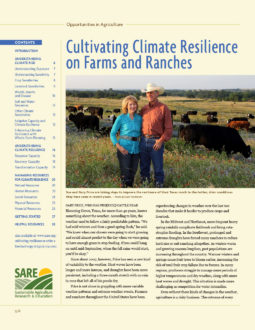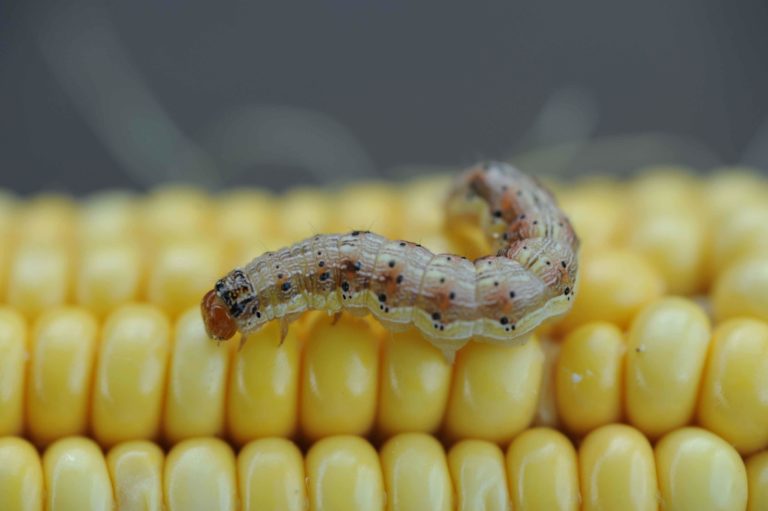Changes in temperature and precipitation patterns, coupled with increased levels of atmospheric CO2, also change the incidence, population levels and competitive ability of weeds, insect pests and diseases. Changes that favor pests and diseases can increase production risks and often require modifications to management practices to maintain crop and livestock yields and quality.
Complicating matters is that an increased reliance on pesticides combined with an increasingly favorable environment for pest reproduction can speed up the development of pesticide resistance. In addition, losses to productivity can be compounded when a climate effect favors a pest species while also placing temperature- or moisture-related stress on a crop or livestock species.
Weeds
With unpredictable temperatures and varying water availability, weed management will become more difficult, especially in seasons that become warmer and wetter, because weed growth will speed up while the period in which soil conditions permit cultivation will become narrower and more variable. Herbicides may also become less reliable because increasing atmospheric CO2 levels have varying effects on herbicide efficacy. For example, a two-year greenhouse study conducted by the USDA Agricultural Research Service in Beltsville, Md., found that at elevated CO2 levels, the efficacy of glyphosate, the most commonly used herbicide in the United States, was reduced for lambsquarters, Canada thistle and quackgrass. Its efficacy in the study was unchanged for pigweed.
Longer growing seasons have made weed management on Rosmann’s Iowa farm more difficult. This is especially true for giant ragweed. A long-term challenge in the low-lying areas of the farm, giant ragweed began moving uphill during the last five years. “We historically were not even thinking about planting corn until May 1, but now the giant ragweed are already getting big by then,” Rosmann said. “They are a tough weed to take out with cultivation.” Rosmann thinks the combination of wetter weather in May and June, earlier spring warm-up, and the longer growing season are promoting the spread of the weed.
With warming temperatures, current weed distributions will likely shift north, changing the mix of weed species on the farm or ranch as some common weeds leave the system and new weeds enter. Fluctuating water availability will have highly variable effects on weed success because drought tolerance varies widely among both weed and crop species. As a general rule, farmers and ranchers can look to comparable production systems to the south or in regions where current climate conditions are similar to projected conditions in their region for insight about troublesome weed challenges ahead. Monitoring weed populations and the efficacy of weed-management efforts will also become important under changing weather conditions.
Insects
Many of the observations about climatic effects on weeds hold true for insect pests. With warming temperatures and longer growing seasons, pest populations increase because pest species can produce more generations in each growing season, which can lead to more damage to crops and livestock. These conditions also change the mix and relative numbers of existing populations and create opportunities for the introduction of novel species. For many pests, it also appears that rising temperatures to date have reduced stress from cold temperatures and have thus increased winter survival without adding stress from maximum temperatures. This has led to a northward expansion of range without a southern retreat.
Management of insect pests will almost certainly become more challenging and costly as pest populations increase, generation times decrease and ranges expand northward. For example, sweet corn has traditionally been treated for corn earworm from 15 to 32 times per season in Florida, four to eight times in Delaware and zero to five times in New York. As growing conditions similar to Florida’s extend northward due to changing weather patterns, an increase in the abundance of earworm is likely to extend with it, increasing pest-management costs. In addition, more frequent pest reproduction and increased exposure to pesticides through a longer growing season can lead to the development of resistance to pesticides more quickly.
There is some evidence from the tropics that a changing climate may reduce the efficacy of existing cultural and biological pest-management strategies as well. For example, changing seasonal weather patterns have disrupted the synchrony between pest and control agent in some tropical crops like oil palm. In theory, if predator and prey respond to different cues—one to changing temperatures, the other to changing day length, for example—then the chance of a mismatch is high. If the predator is a specialist, then there is a greater chance that a timing mismatch will reduce predator populations. Mismatches like these will likely have the greatest effect on crop damage early in the growing season when it is most likely that a mismatch between predator and prey will happen. Agricultural scientists expect that these sorts of mismatches in agricultural crops will grow more common in the future.
Because of these uncertainties and a lack of research-based information, regular on-farm monitoring of insect populations will become increasingly important as a way to keep track of changing pest populations and the performance of insect-pollinated crops. As with weed management, to get a glimpse of future insect pest challenges, producers can look to comparable production systems under climate conditions that are similar to those projected for their region.
Diseases
Like weed and insect management, disease management is likely to become more difficult and costly. Changes in seasonal weather patterns, more extreme weather events and increasing atmospheric CO2 levels are likely to cause changes in the timing, spread and ability of disease organisms to cause infection. This will complicate cultural and biological management, and if producers rely increasingly on pesticides as a result, it may cause resistance to emerge more rapidly. The introduction of new crops and livestock that can better deal with climate risk may also have the unintended consequence of increasing the risk of introducing new diseases, and may create new opportunities for existing diseases as well.
Like other growers in the humid East, Elizabeth Henderson, who has grown organic vegetables at Peacework Organic CSA for more than 25 years near Newark, N.Y., has seen a startling increase in crop disease with the changes in weather over the last decade. “In my first 15 years of farming, we never lost an entire crop to a disease,” Henderson said. “You would have some disease on some of the crop, or some pest, but in the past 10 to 15 years, we’ve had things like powdery mildew blow in and entirely wipe out all the cucumbers. Or late blight totally wipe out the tomatoes and potato crop.”
Hotter summers, more frequent heavy rainfall, more frequent drought and novel diseases have required some adjustments to the Henderson farm’s management practices.
The same is true of Ken Dawson. At his 16-acre diversified organic vegetable farm near Durham, N.C., earlier arrival of downy mildew, a devastating disease of cucurbits, has required Dawson to adjust his plantings of crops like cantaloupes and winter squash. Downy mildew survives the winter in Florida and moves up the East Coast as summer temperatures increase.
“It used to be that downy mildew would appear in eastern North Carolina in early August and then move westward,” said Dawson. “We could safely grow crops up until sometime in August and then those diseases would come. In the last three or four years, downy mildew has started appearing in June. In response to that, we shifted our plantings of susceptible crops earlier by at least a month, because if we plant it later, it all dies before it matures.”
In addition to the impact on crop health, regional warming and variability in seasonal rainfall patterns may also change the spatial and temporal distribution of livestock diseases sensitive to temperature and moisture, such as anthrax, blackleg and hemorrhagic septicemia, as well as increased incidence of ketosis, mastitis and lameness in dairy cattle. This may be compounded further by the fact that weather-related stress can compromise livestock resistance to disease.
Jim Hayes has noticed that wetter conditions and warmer temperatures, particularly in winter, have increased parasite pressures in his sheep flock. “We’ve been here a long time and the winters are not anywhere near as severe as they used to be,” he said. “About eight years ago or so, we started really having problems with heavy parasite loads.”
Hayes found that conventional deworming practices were becoming less effective, so he started using the FAMACHA system to manage the use of dewormers and to increase the flock’s natural resistance to parasites. The FAMACHA system involves regular monitoring of the level of infestation of Haemonchus, a major parasite of sheep, with a simple eyelid test. FAMACHA is widely used among small ruminant producers in the United States and has been the focus of extensive SARE-funded research and education projects by agriculture professionals and producers.
To reduce parasite pressures, Hayes also shifted to a novel type of rotational grazing, known as mob grazing. This involves managing pastures in more mature growth phases with high-intensity grazing over very short time periods. “Now we’re letting the grass grow longer and we may only take 30 percent of the available forage from the top down,” Hayes explained. “We have a higher residual level of thatch, and the sheep aren’t grazing so close to the ground, so we’re having fewer parasite problems.” He has noticed some other benefits of mob grazing as well, including better weight gains, increased forage production, better production during dry periods, faster recovery after grazing and improved soil health.

